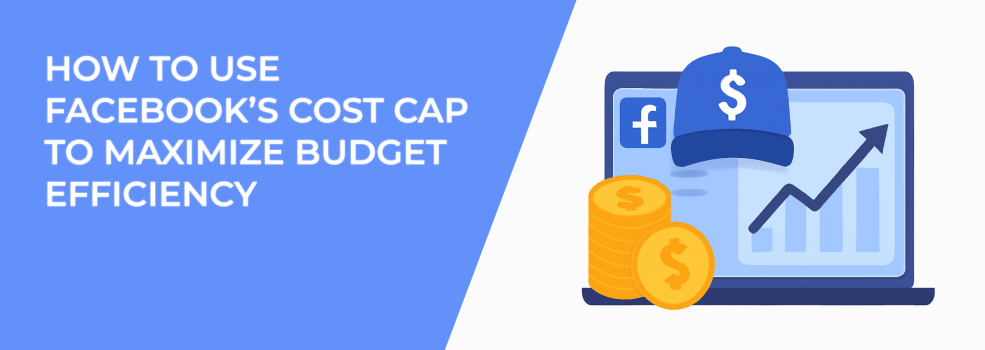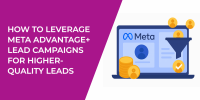When it comes to Facebook ads, every advertiser’s ultimate goal is to drive conversions while maintaining budget control. But with multiple bidding strategies available, choosing the right one can feel overwhelming. Enter Cost Cap—a Facebook bidding strategy that helps you maximize your ad performance while keeping costs predictable. If you're looking to get the best results without overspending, here's how to use the Cost Cap strategy to boost your budget efficiency.
What is Facebook’s cost cap?
The Cost Cap strategy allows you to set a maximum amount you're willing to pay per result, such as a conversion or a purchase. Essentially, you’re telling Facebook that you're okay with spending up to this amount per action, but no more. Facebook then works to keep your average cost per result at or below that specified cap while maximizing the number of results you get.
For example, let’s say you’re running an e-commerce campaign and are willing to spend no more than $5 per purchase. If Facebook delivers 10 purchases and some of them cost $1 each while others go up to $10, the average cost per purchase will remain at $5, staying within your set cap.
Why should you use Cost Cap?
You might be wondering: why choose Cost Cap over other strategies like Bid Cap or Lowest Cost? Here are a few compelling reasons to consider it:
Budget control
Unlike some other strategies, Cost Cap puts a hard limit on how much you’re willing to pay per result. This is perfect for advertisers who want to stick to a set budget without worrying about overspending. With Cost Cap, you’re in control, but still able to scale.
You’ll know exactly how much you’re spending per conversion and won’t be surprised by high costs. This makes it easier to stick to your overall marketing budget.
By setting a cost cap, you are essentially creating a “ceiling” for your spending, which provides financial peace of mind throughout the campaign.
Maximized results within your budget
The beauty of Cost Cap is that it helps you strike a balance between cost control and the volume of conversions you’re getting. You don’t have to compromise on either—Facebook’s algorithm will work to get you the most conversions at or below the set cost.
This gives you peace of mind knowing that your ad spend is optimized for both cost and performance. You get the best of both worlds: efficient spending and high-volume results.
It's a smart choice when you want to maximize the impact of every dollar spent while still reaching the highest number of potential customers.
Predictable performance
With Cost Cap, you can better predict your ad spending. If you have a specific CPA (Cost Per Acquisition) target, you’ll know exactly what you’re spending per conversion, making it easier to measure the effectiveness of your campaigns.
This predictability allows for more accurate budgeting and performance tracking. It ensures you stay within your financial goals while still hitting your performance targets.
Knowing exactly what your ad spend is yielding allows for greater strategic planning and helps prevent unforeseen overspending as the campaign progresses.
How to set up Cost Cap
Setting up Cost Cap is simple and involves just a few steps.
1. Select the right bid strategy
Start by choosing Cost Per Result Goal as your bid strategy in your campaign settings. This is where you’ll set your maximum cost per result.
This selection ensures that you’re in control of the cost while Facebook works to get you results. It sets the framework for how Facebook will handle your ad delivery and budget optimization.
This step is essential to make sure you’re aligned with your campaign goals and have the right control over your ad spend.
2. Set your maximum CPA
Let’s say you’re comfortable paying no more than $10 per conversion. In this case, you’ll set your Cost Cap at $10. Facebook will then work to keep your average cost per conversion at or below that amount.
This way, you’re ensuring that Facebook won’t exceed your cost expectations. It helps keep your ad campaigns on track without any surprises in terms of spending.
Setting this limit also gives you confidence that Facebook’s algorithm is working within your financial boundaries.
3. Monitor and adjust
After launching your campaign, check in regularly to see how it’s performing. If your cost per result is under your target, great—consider scaling your budget. If it’s over your target, you may want to adjust your cost cap or refine your targeting.
Regular monitoring will help you stay on track and make timely adjustments if needed. It’s crucial to keep a close watch on performance so you can optimize while your campaign is live.
By staying proactive with monitoring, you can adapt quickly to market changes and optimize in real-time.
When to use Cost Cap vs. Bid Cap
Both Cost Cap and Bid Cap are useful strategies, but which one you should choose depends on your campaign goals.
Bid Cap allows you to set a maximum bid that Facebook can use in the ad auction. You’re controlling how much Facebook bids for individual actions, but you're not directly controlling the cost per result. This can be ideal if you're trying to control how much you're paying for specific actions (e.g., clicks or conversions), but it can limit how many people see your ads.
It works best if you're trying to ensure you never go above a certain bid price for each individual action. However, it doesn’t optimize for the overall cost-effectiveness of your campaign like Cost Cap does. Bid Cap may offer you tighter control over individual bids, but the trade-off could be fewer opportunities for Facebook to optimize your budget and reach.
If you want to control the average cost per result — like the cost per purchase or cost per lead — while still getting a good volume of results, Cost Cap is your best bet. It helps you optimize for conversions within your budget constraints.
This strategy gives you control over the cost per result without limiting your reach. It’s perfect when you have a set budget and want to ensure that you're getting the most for your money.
Which one to use depends on your priorities. If you have a set budget and want Facebook to focus on maximizing results within your cost limits, go with Cost Cap. If you're more focused on controlling your bid price for each action, Bid Cap might be a better choice.
Maximizing your budget with Cost Cap: key tips
1. Test your target cost
Start by testing your cost cap with a small budget. This will help you get a feel for how Facebook optimizes delivery within your set cap. If you’re getting results that align with your goals, consider scaling your budget.
Testing helps refine your strategy and understand what works best for your campaign. It also helps prevent overspending by testing on a smaller scale before going big.
By running these tests, you can fine-tune your approach to ensure the best results with minimal risk.
2. Pick the right conversion event
The conversion event you choose — such as a purchase or lead generation — directly impacts the performance of your campaigns. Make sure you’re optimizing for the conversion that matters most to your business.
Choosing the right conversion event ensures that Facebook focuses on delivering the results you care about most. It also ensures that Facebook is optimizing for the right action to drive your campaign’s success.
The better your conversion event aligns with your core business goals, the more effective your campaign will be at driving meaningful results.
3. Watch your metrics
Even though Cost Cap provides a solid level of control, it’s essential to keep an eye on your metrics. Track your cost per result, conversion rate, and return on ad spend (ROAS) to ensure your campaigns are on track. If something isn’t performing well, don’t be afraid to make adjustments.
Regular checks will keep your campaign efficient and help you stay aligned with your goals. Analyzing performance regularly allows you to catch any underperforming ads early.
Regular performance analysis helps ensure that your strategy is still on point, and any underperformance can be addressed swiftly.
If you're worried about underperforming ads, Why You See 'Ad Set May Get Zero' provides practical steps to address this issue. Ensuring your ad set isn’t underperforming will help you get the most out of your Cost Cap strategy.
4. Understand your margins
Before setting your Cost Cap, think about your profit margins. Setting a target too high could eat into your profits, while setting it too low could limit your results. Find a balance that aligns with your business goals and profitability.
A clear understanding of your margins ensures you're optimizing for both cost-efficiency and business growth. This balance will help you stay competitive while maintaining profitability.
Knowing your margins will guide you in selecting the most efficient Cost Cap that maximizes both results and profitability.
5. Pair Cost Cap with audience targeting
The more relevant your audience, the better your results will be. Use Facebook’s custom audiences or lookalike audiences to target people who are more likely to convert. This can help improve your campaign’s efficiency and reduce costs.
Smart audience targeting will help you get the best bang for your buck by focusing on those most likely to convert. Combining Cost Cap with the right audience targeting ensures your ads are shown to people who are more likely to take action.
Audience targeting helps Facebook’s algorithm deliver results to the right people, improving the overall efficiency of your ad spend.
You can dive deeper into targeting strategies by checking out our guide on Facebook Ad Targeting 101. This article covers the basics of how to identify and reach the right audience for your Facebook ads, which is essential when setting up Cost Cap for optimal results.
6. Experiment with other optimization features
If you want to get even more out of your campaigns, combine Cost Cap with Facebook’s other features, like Dynamic Creative and A/B testing. This allows you to test different creatives and identify the best-performing combinations.
Experimentation gives you the flexibility to fine-tune your campaigns and maximize their potential. It also lets you continuously improve your ads for better results over time.
By testing variations of your creatives, you can identify which messages and visuals resonate most with your target audience, improving campaign performance.
Campaign Optimization for Facebook Ads is a great follow-up if you're working with a tight budget while utilizing Cost Cap. It provides strategies on how to optimize your budget effectively without overspending.
Conclusion
Cost Cap is an incredibly useful tool for Facebook advertisers who want to stay within budget while still driving conversions. It provides greater control over your cost per result while giving you the flexibility to scale your campaigns. By understanding how to set up and optimize your Cost Cap strategy, you can ensure that you’re getting the best value from your ad spend.
So, how will you use Cost Cap in your next campaign? The balance it offers between cost control and volume makes it a great choice for many types of campaigns—especially if you want to achieve more with your advertising budget. By staying informed and adapting your approach, you can drive better results and ensure that your campaigns perform at their best.

